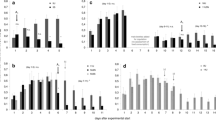Abstract
Tobacco was fumigated to control the cigarette beetleLasioderma serricorne (Fabr.) with a fumigant based on magnesium phosphide (Detiaphos R) in hogsheads and cartons at temperatures almost constantly below freezing point and alternatively at temperatures which increased or decreased very slowly in the course of the fumigation.
The dosage was 1 g PH3 per m3 and the fumigation lasted 96 h in all cases. Gas concentration measurements in the tobacco and under sheeting showed that PH3 developed rapidly in lethal concentrations from magnesium phosphide at low temperatures.
Complete mortality of the inserred test insects was registered after the 96 h fumigation period. With magnesium phosphide, a fumigant is available which can be used for fumigating tobacco even at low temperatures.
Zusammenfassung
Tabak in Fässern und Kartons wurde zur Tabakkäferkontrolle mit einem Begasungsmittel auf Basis Magnesiumphosphid (Detiaphos®) begast. Die Umgebungstemperaturen lagen dabei überwiegend unter dem Gefrierpunkt bzw. stiegen oder fielen langsam im Laufe der Begasung.
Die Dosierung betrug 1 g PH3/m3, und die Begasung dauerte 96 h. Gaskonzentrationsmessungen im Tabak und unter der Begasungsplane zeigten, daß sich PH3 auch bei niedrigen Temperaturen sehr schnell aus Magnesiumphosphid entwickelt und frühzeitig letale Konzentrationen erreicht. Eine Begasungsdauer von 96 h führte zu vollständiger Abtötung der eingebrachten Testinsekten. Somit steht mit Magnesiumphosphid ein Begasungsmittel zur Verfügung, das auch bei niedrigen Temperaturen zur Tabakbegasung eingesetzt werden kann.
Similar content being viewed by others
Literature cited
Childs, D. P.; Overby, J. E.; Cox, E. L.; Niffenegger, D., 1973: Toxicity of Phosphine at various concentrations and temperatures to the cigarette beetle. USDA circ. ARS-S-16, 8 pp.
Wohlgemuth, R., 1985: Phosphine permeability of various plastic sheets and films. Bull. OEPP/EPPO15, 59–64.
Breyer, D., 1973: Investigations into the residues of hydrogen phosphide in cereal grains after treatment with powdery fumigants. Die Mühle und Mischfuttertechnik110, 699–700.
Meuser, F.;Rajani, Ch.;Reimers, H., 1977: Determination of the Rate of Hydrolysis of Pellitized Metal Phosphides for Grain Fumigation. Die Mühle und Mischfuttertechnik114, 435–438.
Faustini, D. L., 1983: Magnesium Phosphide as a fumigant for control of the cigarette beetle,Lasioderma serricorne (F.) at low temperatures. In: Proceed, of the Third Intern. Working Conf. on Stored Product Entomology, Manhattan, Kansas, October 23–28, 1983.
Halliday, D., 1986: Phosphine formulations for use in developing countries. In: GASGA Seminar on Fumigation Technology in Developing Countries, March 18–21, 1986.
Author information
Authors and Affiliations
Additional information
With 6 tables and 3 figures
Rights and permissions
About this article
Cite this article
Münzel, M. Examination of efficacy of magnesium phosphide (Detiaphos R) against the cigarette beetleLasioderma serricorne (Fabr.) (Col., Anobiidae) at low temperatures. Anz. Schadlingskde., Pflanzenschutz, Umweltschutz 60, 74–78 (1987). https://doi.org/10.1007/BF01905729
Issue Date:
DOI: https://doi.org/10.1007/BF01905729



